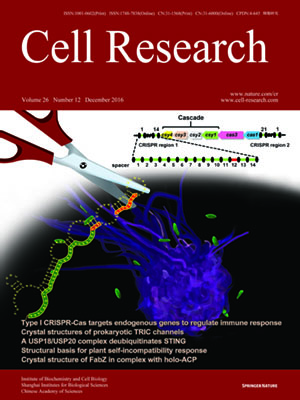
Volume 26, No 12, Dec 2016
ISSN: 1001-0602
EISSN: 1748-7838 2018
impact factor 17.848*
(Clarivate Analytics, 2019)
Volume 26 Issue 12, December 2016: 1288-1301 | Open Access
ORIGINAL ARTICLE
Crystal structures of the TRIC trimeric intracellular cation channel orthologues
Go Kasuya1, Masahiro Hiraizumi1, Andrés D Maturana2, Kaoru Kumazaki1, Yuichiro Fujiwara3, Keihong Liu4, Yoshiko Nakada-Nakura4, So Iwata4, Keisuke Tsukada1, Tomotaka Komori1, Sotaro Uemura1, Yuhei Goto5, Takanori Nakane1, Mizuki Takemoto1, Hideaki E Kato1,10, Keitaro Yamashita6, Miki Wada7, Koichi Ito8, Ryuichiro Ishitani1, Motoyuki Hattori9 and Osamu Nureki1
1Department of Biological Sciences, Graduate School of Science, The University of Tokyo, 2-11-16 Yayoi, Bunkyo-ku, Tokyo 113-0032, Japan
2Department of Bioengineering Sciences, Graduate School of Bioagricultural Sciences, Nagoya University, Furo-cho, Chikusa-ku, Nagoya 464-8601, Japan
3Integrative Physiology, Department of Physiology, Graduate School of Medicine, Osaka University, 2-2 Yamada-oka, Suita, Osaka 565-0871, Japan
4Department of Cell Biology, Graduate School of Medicine, Kyoto University, Yoshida-Konoe-cho, Sakyo-ku, Kyoto 606-8501, Japan
5Laboratory of Chromosome Dynamics, Institute of Molecular and Cellular Biosciences, The University of Tokyo, 1-1-1, Yayoi, Bunkyo-ku, Tokyo 113-0032, Japan
6SR Life Science Instrumentation Unit, RIKEN SPring-8 Center, 1-1-1 Kouto, Sayo-cho, Sayo-gun, Hyogo 679-5148, Japan
7Technical office, The Institute of Medical Science, The University of Tokyo, 4-6-1 Shirokanedai, Minato-ku, Tokyo 108-8639, Japan
8Department of Medical Genome Sciences, Graduate School of Frontier Sciences, The University of Tokyo, 5-1-5 Kashiwanoha, Kashiwa-shi, Chiba 277-8562, Japan
9State Key Laboratory of Genetic Engineering, Collaborative Innovation Center of Genetics and Development, Department of Physiology and Biophysics, School of Life Sciences, Fudan University, 2005 Songhu Road, Shanghai 200438, China
10Current address: Department of Molecular and Cellular Physiology, Stanford University School of Medicine, Stanford, California 94305, USA.
Correspondence: Motoyuki Hattori, E-mail: hattorim@fudan.edu.cn; Osamu Nureki, E-mail: nureki@bs.s.u-tokyo.ac.jp
Ca2+ release from the sarcoplasmic reticulum (SR) and endoplasmic reticulum (ER) is crucial for muscle contraction, cell growth, apoptosis, learning and memory. The trimeric intracellular cation (TRIC) channels were recently identified as cation channels balancing the SR and ER membrane potentials, and are implicated in Ca2+ signaling and homeostasis. Here we present the crystal structures of prokaryotic TRIC channels in the closed state and structure-based functional analyses of prokaryotic and eukaryotic TRIC channels. Each trimer subunit consists of seven transmembrane (TM) helices with two inverted repeated regions. The electrophysiological, biochemical and biophysical analyses revealed that TRIC channels possess an ion-conducting pore within each subunit, and that the trimer formation contributes to the stability of the protein. The symmetrically related TM2 and TM5 helices are kinked at the conserved glycine clusters, and these kinks are important for the channel activity. Furthermore, the kinks of the TM2 and TM5 helices generate lateral fenestrations at each subunit interface. Unexpectedly, these lateral fenestrations are occupied with lipid molecules. This study provides the structural and functional framework for the molecular mechanism of this ion channel superfamily.
10.1038/cr.2016.140
FULL TEXT | PDF
Browse 1556


